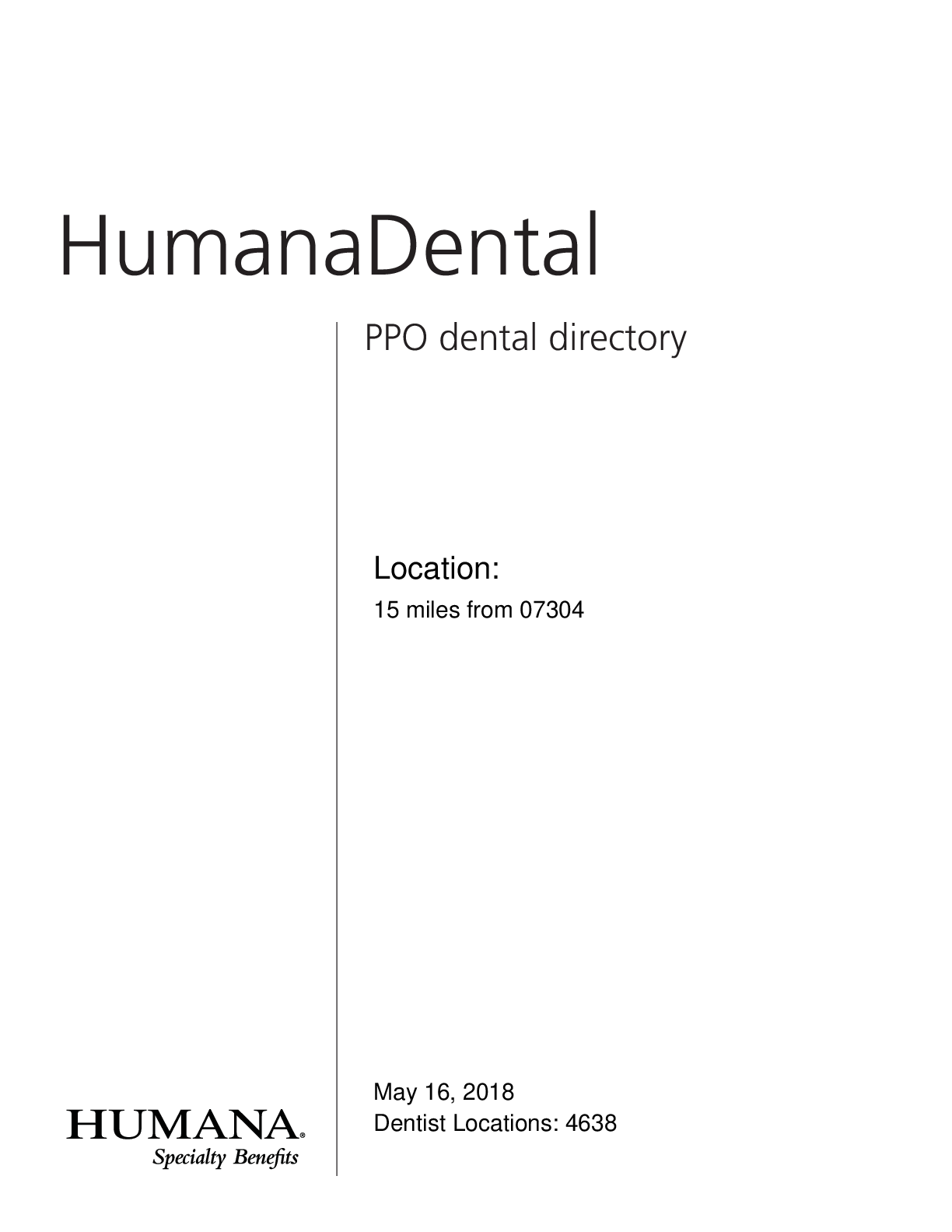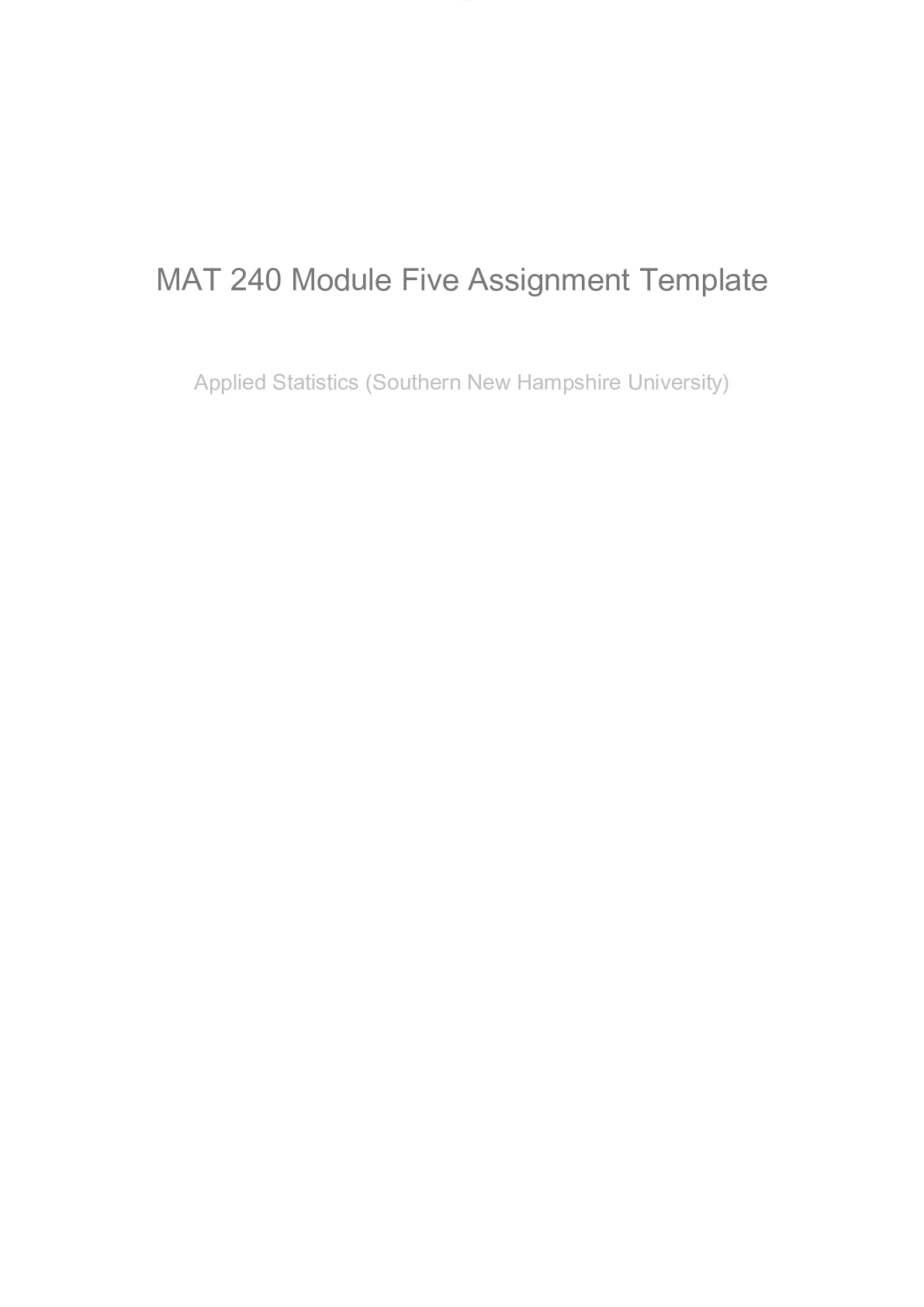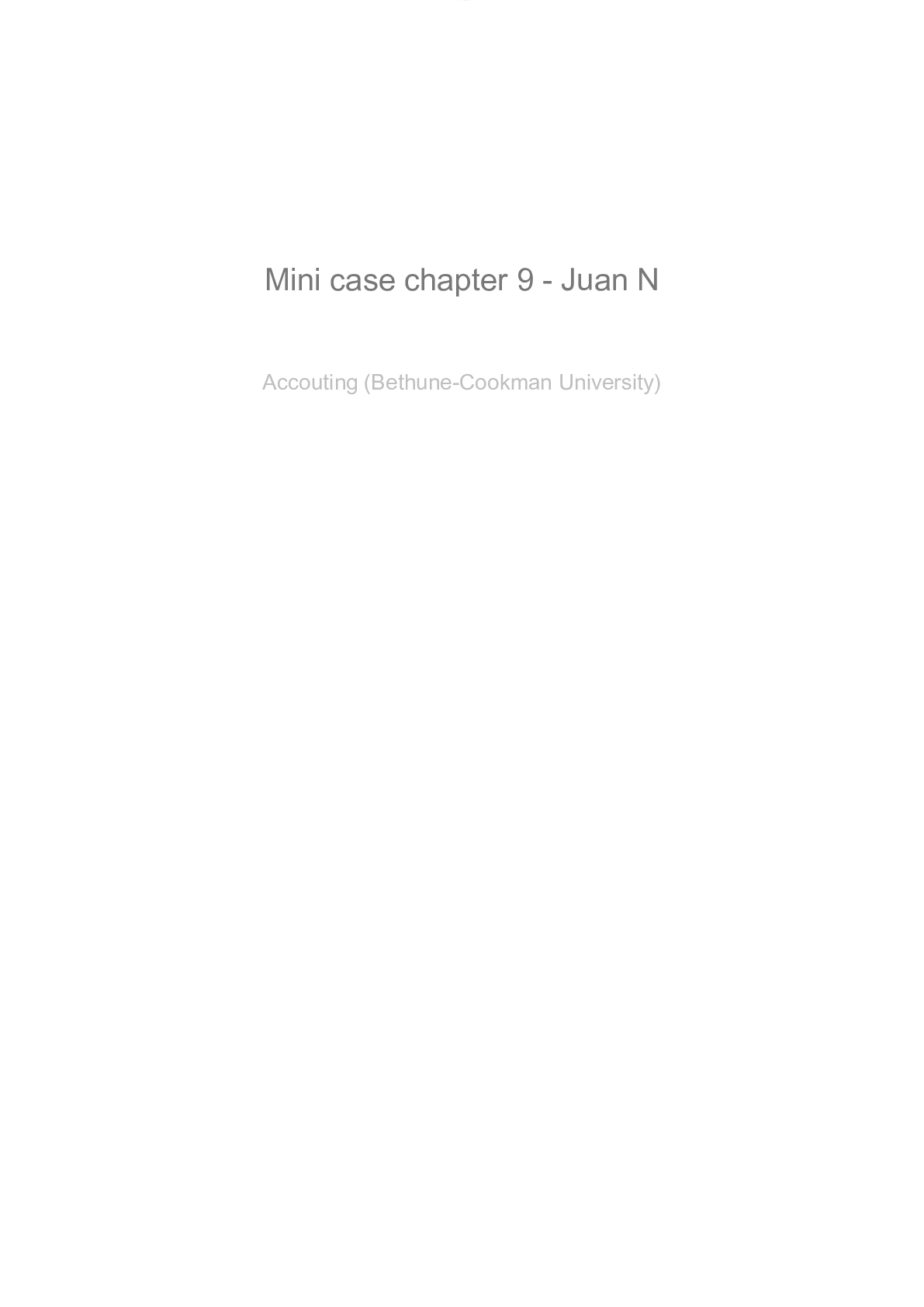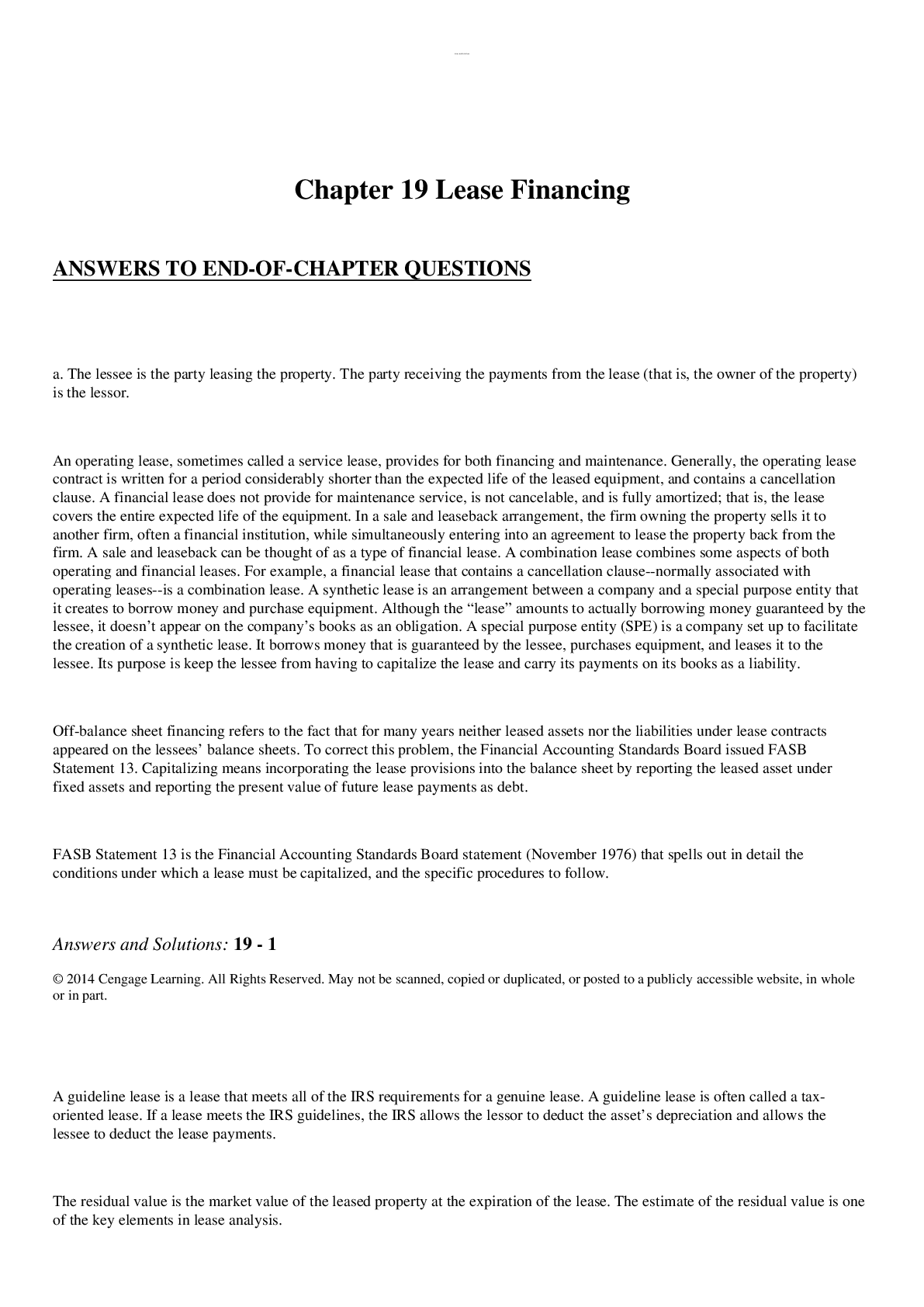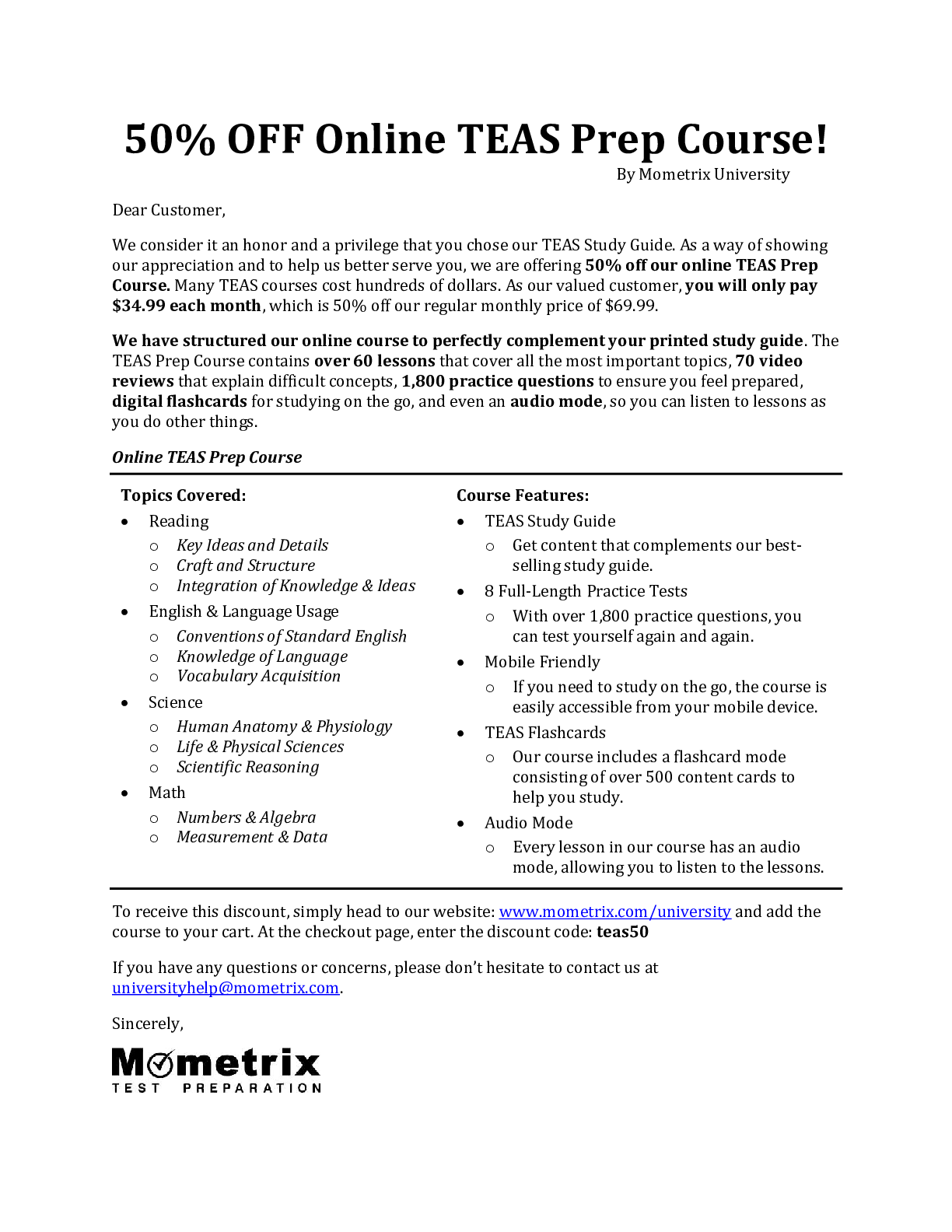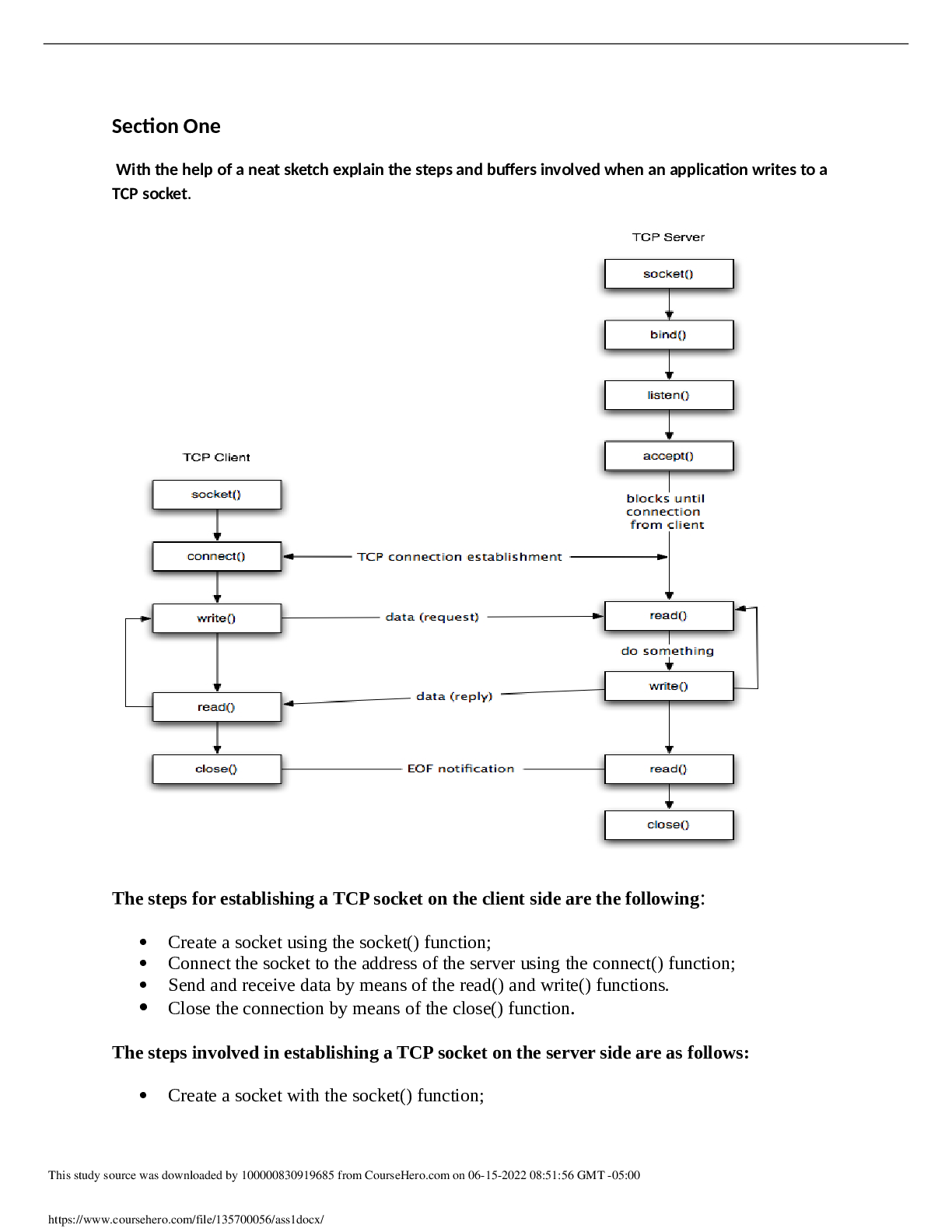*NURSING > Solutions Guide > Social Work Licensing Exam Prep - AWSB BSW MSW/ Social Work License Exam Study Guide Updated Fall 20 (All)
Social Work Licensing Exam Prep - AWSB BSW MSW/ Social Work License Exam Study Guide Updated Fall 2021/2022; Distinction level solution guide.
Document Content and Description Below
Social Work License Exam Study Guide; Spring 2022. Types of Mood Disorders - Dysthymic Disorder, Major Depressive Disorder and Bipolar Disorder Dysthymic Disorder - 1. Dysthymia is a type o... f low-grade depression, 2. Dysthymia is a chronic long -lasting form of depression sharing many characteristic symptoms of major depressive disorder. 3. These symptoms tend to be less severe but do fluctuate in intensity and 4. To be diagnosed, an adult must experience 2 or more of the symptoms of Major Depressive Disorder for at least two years. *Children - symptoms must be present for at least one year. Major Depressive Disorder - 1. Presence of one (or more) major depressive episodes (experiencing at least 4 of the symptoms listed below everyday) lasting at least 2 straight weeks within a 6 month period. 2. Symptoms include: trouble sleeping, sleeping too much, irritability, isolation, loss of appetite, weight gain, tearfulness, loss of interest in activities, headaches, body aches, suicidal ideations, lack of ability to concentrate, feelings of hopelessness and despair. 3. The person's symptoms are a cause distress or difficulty in functioning at home, work, or other important areas (social, occupational, recreational). 4. The person's symptoms are not caused by substance use (e.g., alcohol, drugs, medication) or a medical disorder. Bipolar Disorder - 1. Formerly referred to as "Manic Depression", 2. Bipolar is similar to depression but is characterized by the presence of manic episodes in addition to depression. 3. Manic episodes include: euphoria, racing thoughts, excessive talking, less need for sleep, impulsiveness, and hallucinations (bipolar with psychotic features). Clients may "cycle". Types of Psychotic Disorders - 1. Schizophrenia 2. Schizoaffective Disorder 3. Schizophreniform Schizophrenia - 1. Schizophrenia is described as a psychiatric diagnosis 2. Describes a mental illness characterized by impairments in a person's perceptions or expression of reality. Schizophrenia - Symptoms include: Bizarre speech & appearance Delusions Hallucinations (auditory, visual, olfactory, gustatory, and tactile) Disorganized speech Grossly disorganized or catatonic behavior Flat affect Paranoia Loss of Interest in personal hygiene Schizophrenia: Positive Symptoms - Thought Broadcasting Delusions Ideas of reference Ideas of persecution Delusions of grandeur Hallucinations Schizophrenia: Negative Symptoms - Alogia - Delayed responses to questions comments Anhedonia - inability to experience pleasure Flat affect - monotone voice, absence of facial expressions Social Withdrawal Declining ability to care for self Catatonia Schizophreniform - The main symptoms of schizophreniform include: delusions hallucinations disorganized speech disorganized or catatonic behavior an inability to show emotion - flat affect an inability to experience pleasure impaired or decreased speech a lack of desire to form relationships, and a lack of motivation Symptoms are present for more than 1 month but no longer than 6 months Schizoaffective Disorder - The following are the criteria for a diagnosis of schizoaffective disorder from the DSM-IV-TR: Two (or more) of the symptoms listed on the schizophrenia slide are present for the majority of a one-month period (or a shorter period of time if symptoms got better with treatment): Types of Personality Disorders - 1. Histrionic Personality Disorder 2. Borderline Personality Disorder 3. Narcissistic Personality Disorder 4. Obsessive Compulsive Personality Disorder 5. Antisocial Personality Disorder 6. Schizotypal Personality Disorder 7. Schizoid Personality Disorder Histrionic Personality Disorder - People with this disorder are usually able to function at a high level and can be successful socially and at work. Symptoms include: 1. Acting or looking overly seductive 2. Being easily influenced by other people 3. Being overly concerned with their looks 4. Being overly dramatic and emotional 5. Being overly sensitive to criticism or disapproval 6. Believing that relationships are more intimate than they actually are 7. Blaming failure or disappointment on others 8. Constantly seeking reassurance or approval 9. Having a low tolerance for frustration or delayed gratification 10. Needing to be the center of attention 11. Quickly changing emotions, which may seem shallow to others Borderline Personality Disorder - 1. Relationships with others are intense and unstable. They swing wildly from love to hate and back again. People with BPD will frantically try to avoid real or imagined abandonment. 2. BPD patients may also be uncertain about their identity or self-image. They tend to see things in terms of extremes, either all good or all bad. They also typically view themselves as victims of circumstance and take little responsibility for themselves or their problems. Borderline Personality Disorder - Other symptoms include: 1. Feelings of emptiness and boredom 2. Frequent displays of inappropriate anger 3. Impulsiveness with money, substance abuse, sexual relationships, binge eating, or shoplifting 4. Intolerance of being alone 5. Recurrent acts of crisis such as wrist cutting, overdosing, or self-injury (such as cutting) 6. Manipulates Boundaries Narcissistic Personality Disorder - Narcissistic personality disorder is a condition in which there is an inflated sense of self-importance and an extreme preoccupation with one's self. Narcissistic Personality Disorder - A person with narcissistic personality disorder: 1. Reacts to criticism with rage, shame, or humiliation 2. Takes advantage of other people to achieve his or her own goals 3. Has feelings of self-importance 4. Exaggerates achievements and talents 5. Is preoccupied with fantasies of success, power, beauty, intelligence, or ideal love 6. Has unreasonable expectations of favorable treatment 7. Requires constant attention and admiration 8. Disregards the feelings of others, lacks empathy 9. Has obsessive self-interest 10. Pursues mainly selfish goals Antisocial Personality Disorder - A pervasive pattern of disregard for and violation of the rights of others. Symptoms usually begin in childhood or early adolescence. Antisocial Personality Disorder - Symptoms include: 1. Use of aliases, criminal and/ or manipulative behavior, 2. Impulsivity, reckless disregard for safety of self or others, 3. Lack of remorse, irritability and aggressiveness evidenced by pattern of physical fights or assaults, 4. Deceitfulness, 5. Failure to conform to social norms and lawful behavior. Obsessive Compulsive Personality Disorder - 1. Obsessive-Compulsive Personality Disorder is a condition characterized by a chronic preoccupation with rules, orderliness, and control. 2. This disorder is only diagnosed when these behaviors become persistent and disabling. 3. The individual with this disorder often becomes upset when control is lost. 4. The person then either emotionally withdraws from these situations, or becomes very angry. 5. The person often has difficulty expressing tender feelings, and rarely pays compliments. Schizotypal Personality Disorder - 1. Schizotypal personality disorder is a serious condition in which a person usually has few to no intimate relationships. 2. These people tend to turn inward rather than interact with others, and experience extreme anxiety in social situations. 3. People with schizotypal personality disorder often have trouble engaging with others and appear emotionally distant. 4. They find their social isolation painful, and eventually develop distorted perceptions about how interpersonal relationships form. 5. They may also exhibit odd behaviors, respond inappropriately to social cues and hold peculiar beliefs. Schizotypal, continued - Symptoms of schizotypal personality disorder include: 1. Incorrect interpretation of events, including feeling that external events have personal meaning 2. Peculiar thinking, beliefs or behavior (magical thinking) 3. Belief in special powers, such as telepathy 4. Perceptual alterations, in some cases bodily illusions, including phantom pains or other distortions in the sense of touch 5. Idiosyncratic speech, such as loose or vague patterns of speaking or tendency to go off on tangents 6. Suspicious or paranoid ideas 7. Flat emotions or inappropriate emotional responses 8. Lack of close friends outside of the immediate family 9. Persistent and excessive social anxiety that doesn't abate with time Schizoid Personality Disorder - 1. Schizoid personality disorder is a condition in which people avoid social activities and consistently shy away from interaction with others. 2. People with the disorder are generally loners with a profound inability to connect with others and form personal relationships. 3. To others, people with schizoid personality disorder may appear aloof and dull, and they're often ignored in social settings. 4. People with schizoid personality disorder show a flattened or restricted range of emotions, and can appear indifferent to what's going on around them. 5. However, their inner life can be rife with a deep emotional need, sensitivity and confusion about the world around them. Schizoid Personality Disorder - People with schizoid personality disorder are loners. Generally they: 1. Choose activities that don't require interaction with others 2. Prize solitude and independence 3. Are often unable to respond to normal social cues in social settings 4. Harbor little desire for sexual experiences with others 5. Can appear dull or indifferent to others 6. Are followers rather than leaders in groups Anxiety Disorders - Anxiety Disorders include: 1. Post Traumatic Stress Disorder 2. Generalized Anxiety Disorder 3. Attention Deficit Hyperactivity Disorder 4. Obsessive Compulsive Disorder 5. Acute Stress Disorder Post Traumatic Stress Disorder - 1. Formerly known as shell shock, a term associated with combat related trauma 2. PTSD is the response to trauma such as: a. hazardous events b. violent and / or sexual assaults c. natural disasters, accidents d. torture, childhood sexual abuse e. incarceration, and military combat. Post Traumatic Stress Disorder - Symptoms include: 1. violence or aggression, 2. frightening thoughts and memories associated with ordeal, 3. reliving the event, 4. problems sleeping, 5. avoiding situations reminiscent of stressors, 6. nightmares, 7. psychic numbing, and flashbacks. Post Traumatic Stress Disorder, continued - 1. Flashbacks can be triggered by smells, sights, or sounds. 2. Auditory hallucinations and paranoia are present in more severe cases of PTSD. 3. Symptoms usually after within 1 month of traumatic event (in most cases 1 month after the event occurred) and must last at least one month to fit the diagnostic criteria for PTSD. Acute Stress Disorder - 1. Acute Stress Disorder is similar to Post Traumatic Stress Disorder in that the symptoms are present in response to a crisis situation or hazardous event. 2. The main difference between Acute Stress Disorder symptoms manifest immediately after the traumatic event. 3. If the symptoms are still present after one month, the appropriate DX would then be Post Traumatic Stress Disorder. Generalized Anxiety Disorder - Generalized anxiety disorder (GAD) is a pattern of frequent, constant worry and anxiety over many different activities and events. Generalized Anxiety Disorder, continued - Generalized anxiety disorder has the following symptoms: 1. Difficulty concentrating 2. Difficulty controlling worry 3. Excess anxiety and worry that is out of proportion to the situation most of the time 4. Excessive sweating, palpitations, shortness of breath, and stomach/intestinal symptoms 5. Fatigue 6. Irritability 7. Muscle tension -- shakiness, headaches 8. Restlessness or feeling keyed up or "on the edge" 9. Sleep disturbance (difficulty falling or staying asleep; or restless, unsatisfying sleep) ADHD - 1. The DSM-V divides the symptoms of ADHD into those of inattentiveness and those of hyperactivity and impulsivity. 2. To be diagnosed with ADHD, children should have at least 6 attention symptoms or 6 activity and impulsivity symptoms -- to a degree beyond what would be expected for children their age. 3. The symptoms must be present for at least 6 months, observable in 2 or more settings, and not caused by another problem. 4. The symptoms must be severe enough to cause significant difficulties. 5. Some symptoms must be present before age 7. ADHD, continued - 1. Fails to give close attention to details or makes careless mistakes in schoolwork 2. Difficulty sustaining attention in tasks or play 3. Does not seem to listen when spoken to directly 4. Does not follow through on instructions and fails to finish schoolwork, chores, or duties in the workplace 5. Difficulty organizing tasks and activities 6. Avoids or dislikes tasks that require sustained mental effort (such as schoolwork) 7. Often loses toys, assignments, pencils, books, or tools needed for tasks or activities 8. Easily distracted 9. Often forgetful in daily activities hyperactivity symptoms: ADHD, continued - 10. Fidgets with hands or feet or squirms in seat 11. Leaves seat when remaining seated is expected 12. Runs about or climbs in inappropriate situations 13. Difficulty playing quietly 14. Often "on the go," acts as if "driven by a motor," talks Excessively Impulsivity symptoms: 1. Blurts out answers before questions have been completed 2. Difficulty awaiting turn 3. Interrupts or intrudes on others (butts into conversations or games Obsessive Compulsive Disorder - 1. Obsessive-compulsive disorder (OCD) is a type of anxiety disorder in which you have unreasonable thoughts and fears (obsessions - sometimes referred to as ruminations) that lead you to engage in repetitive behaviors (compulsions). 2. With obsessive-compulsive disorder, you may realize that your obsessions aren't reasonable, and you may try to ignore them or stop them. 3. But that only increases your distress and anxiety. Ultimately, you feel driven to perform compulsive acts in an effort to ease your distress. Obsessive Compulsive Disorder, continued - Obsessions often have themes to them, such as: 1. Fear of contamination or dirt 2. Having things orderly and symmetrical 3. Aggressive or horrific impulses 4. Sexual images or thoughts OCD, continued - OCD symptoms involving obsessions may include: 1. Fear of being contaminated by shaking hands or by touching objects others have touched 2. Doubts that you've locked the door or turned off the stove 3. Thoughts that you've hurt someone in a traffic accident 4. Intense distress when objects aren't orderly or facing the right way 5. Images of hurting your child 6. Impulses to shout obscenities in inappropriate situations 7. Avoidance of situations that can trigger obsessions, such as shaking hands 8. Replaying pornographic images in your mind 9. Dermatitis because of frequent hand washing 10. Skin lesions because of picking at your skin 11. Hair loss or bald spots because of hair pulling OCD, continued - OCD compulsion symptoms 1. OCD compulsions are repetitive behaviors that you feel driven to perform. 2. These repetitive behaviors are meant to prevent or reduce anxiety or distress related to your obsessions. 3. For instance, if you believe you ran over someone in your car, you may return to the apparent scene over and over because you just can't shake your doubts. 4. You may also make up rules or rituals to follow that help control the anxiety you feel when having obsessive thoughts. OCD, continued - OCD symptoms involving compulsions may include: 1. Hand washing until your skin becomes raw 2. Checking doors repeatedly to make sure they're locked 3. Checking the stove repeatedly to make sure it's off 4. Counting in certain patterns 5. Making sure all your canned goods face the same way Somatoform Disorders - The Somatoform Disorders include: 1. Conversion Disorder 2. Pain Disorder 3. Hypochondriasis 4. Body Dysmorphic Disorder Conversion Disorders - 1. Conversion disorders are a somatoform disorder characterized by a sudden loss of neurological function, usually in the context of a severe stressor. 2. Specific characteristics of conversion disorder include the following: a. One or more symptoms of loss of voluntary motor or sensory function, eg, inability to walk, sudden blindness. b. No evidence that the symptom is feigned or intentionally produced. c. Loss of function that is not due to medical illness. d. Common conversion symptoms (eg, pseudoseizure, paralysis, becoming mute) Hypochondriasis - 1. Hypochondriasis is disorder characterized by unexplained physical symptoms related to fear of a specific medical condition, ie, a complaint of breast pain perceived as being due to breast cancer when no breast cancer is present. 2. Characteristics of hypochondriasis include the following: a. Preoccupation with fear of having a serious medical illness. b. Bodily symptoms reported consistent with patient's conception of specific illness. c. Preoccupation persists despite medical evaluation and reassurance. d. Fear persists for at least 6 months. Pain Disorder - 1. Pain disorder is a disorder characterized by a focused pain complaint that cannot be entirely attributed to a specific medical disorder. 2. Specific symptoms of pain disorder include the following: a. Pain in 1 or more anatomical site producing a predominant clinical focus ............................... .........................................................Continues [Show More]
Last updated: 1 year ago
Preview 1 out of 53 pages
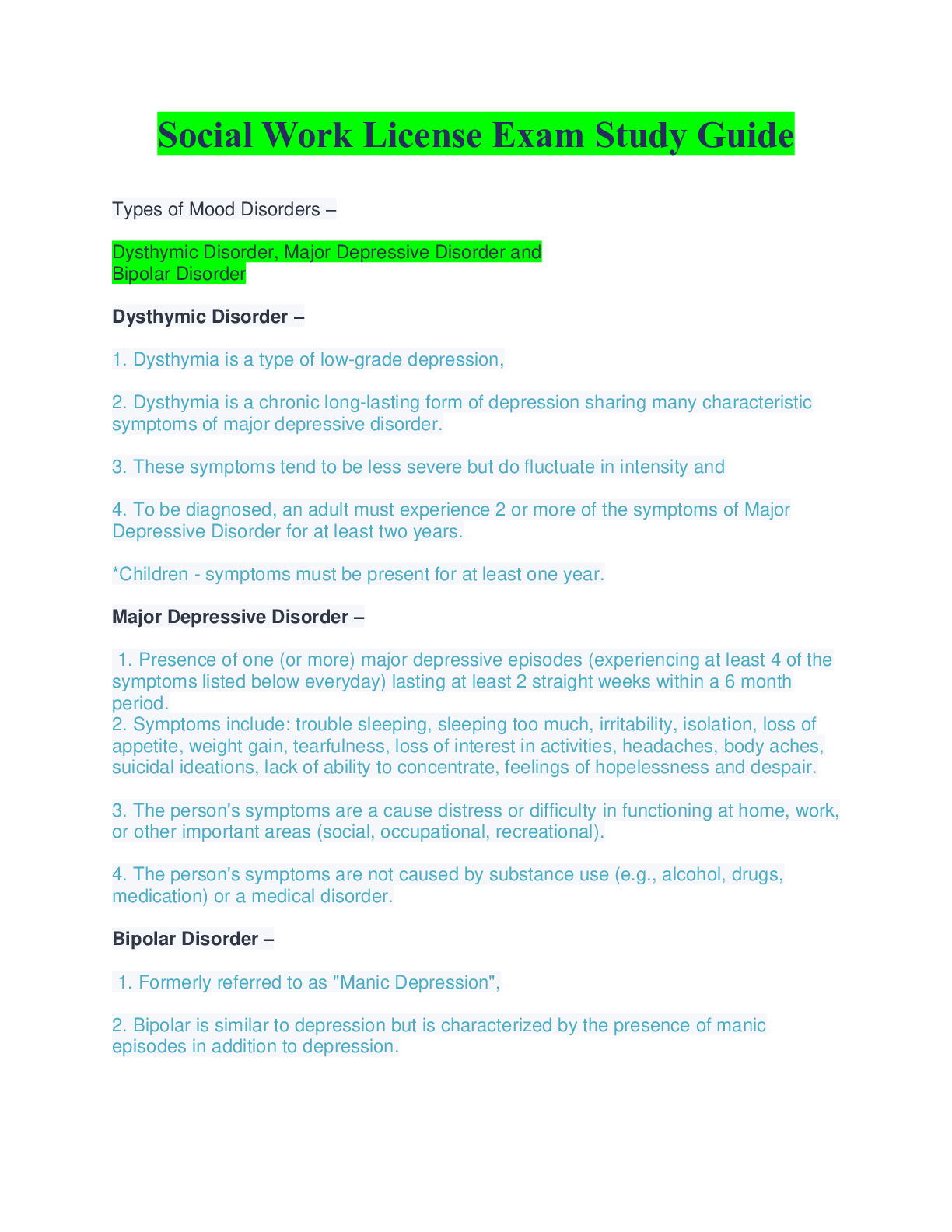
Reviews( 0 )
Document information
Connected school, study & course
About the document
Uploaded On
Mar 10, 2022
Number of pages
53
Written in
Additional information
This document has been written for:
Uploaded
Mar 10, 2022
Downloads
0
Views
99

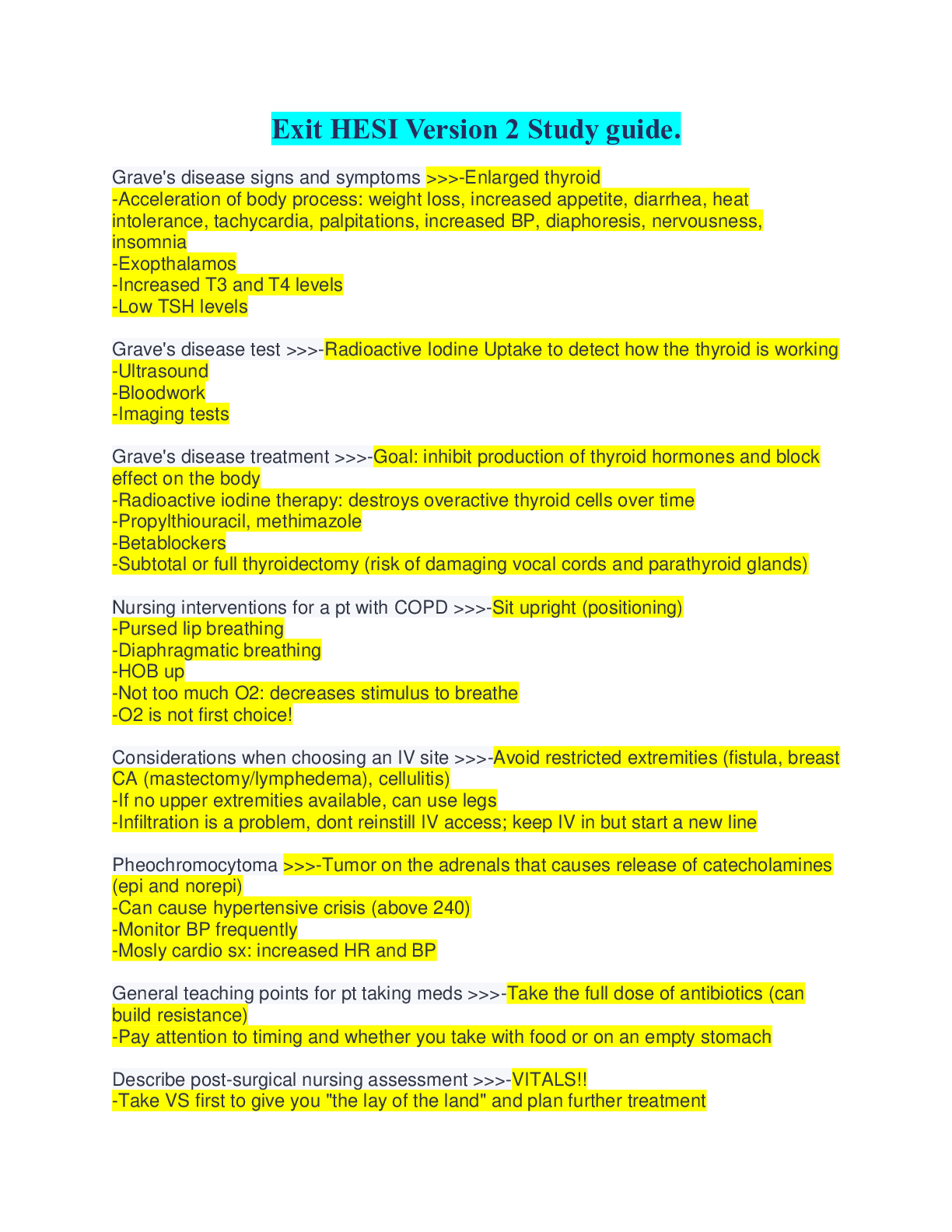
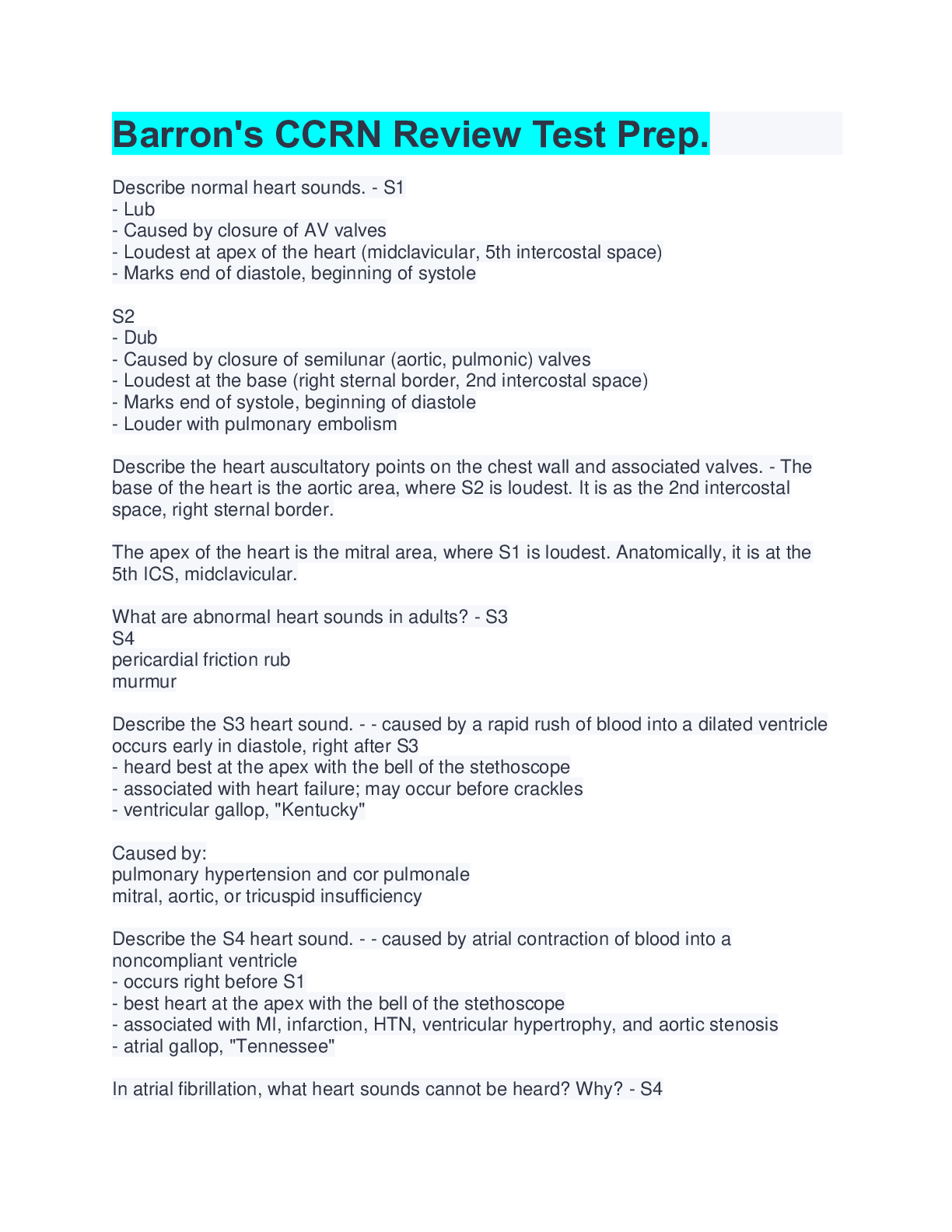

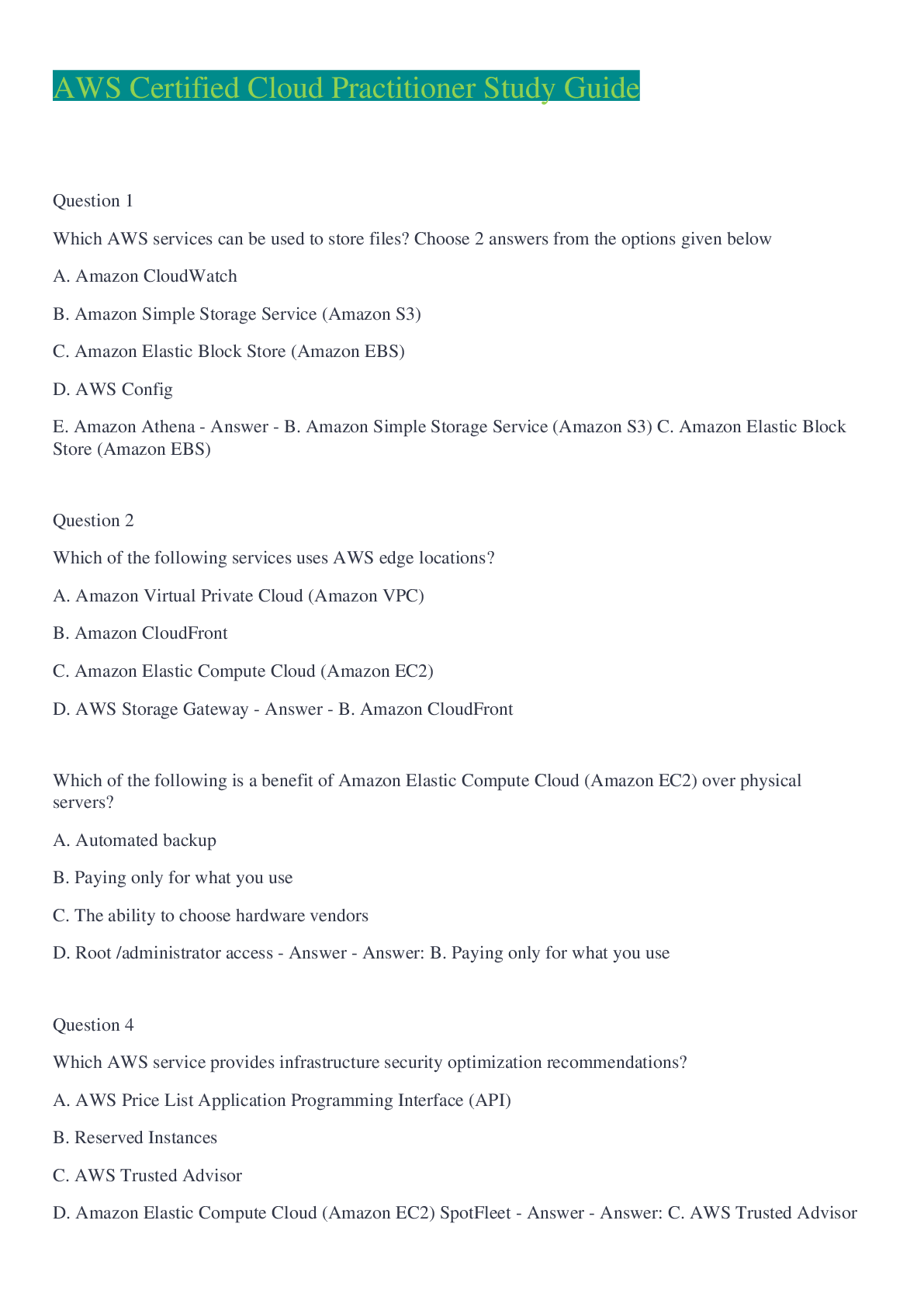
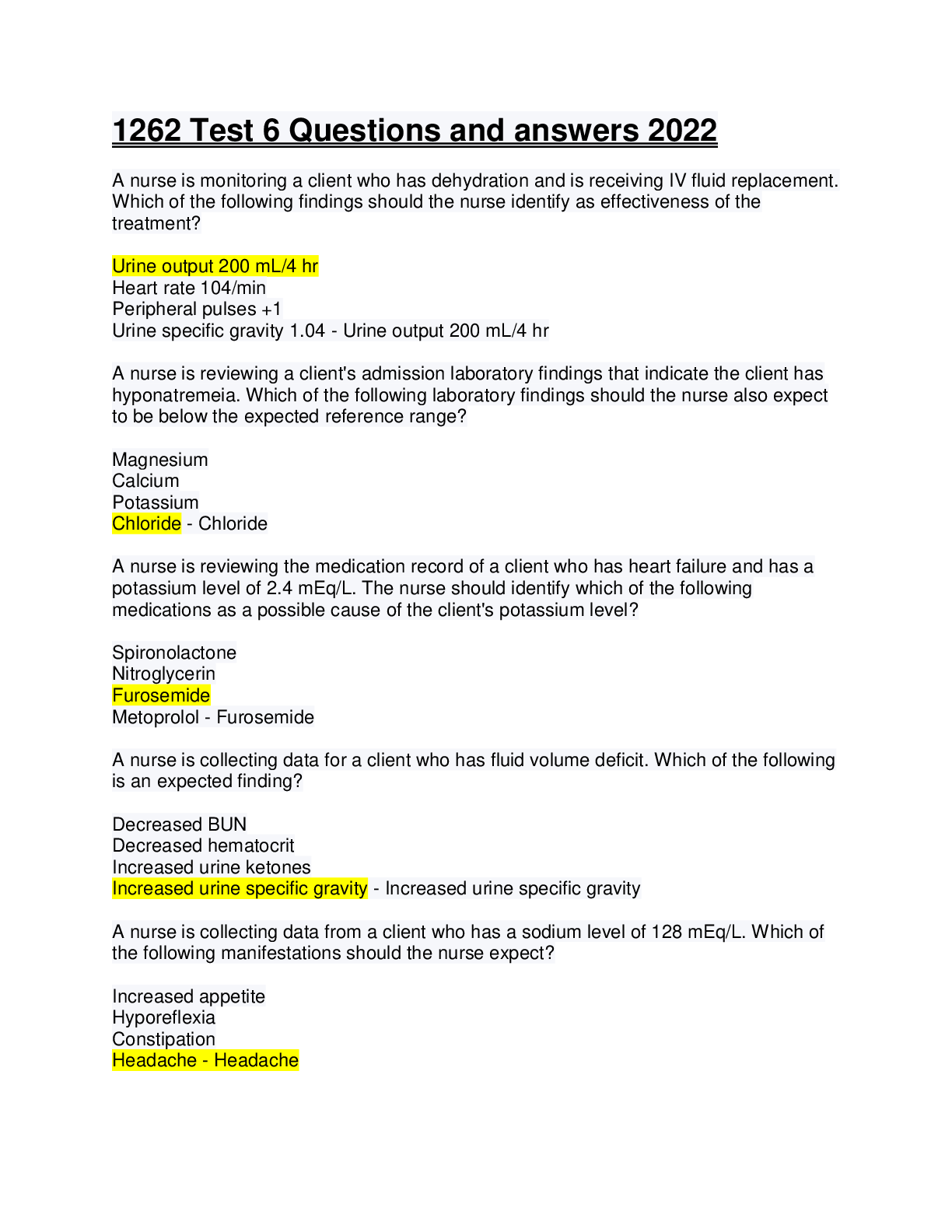
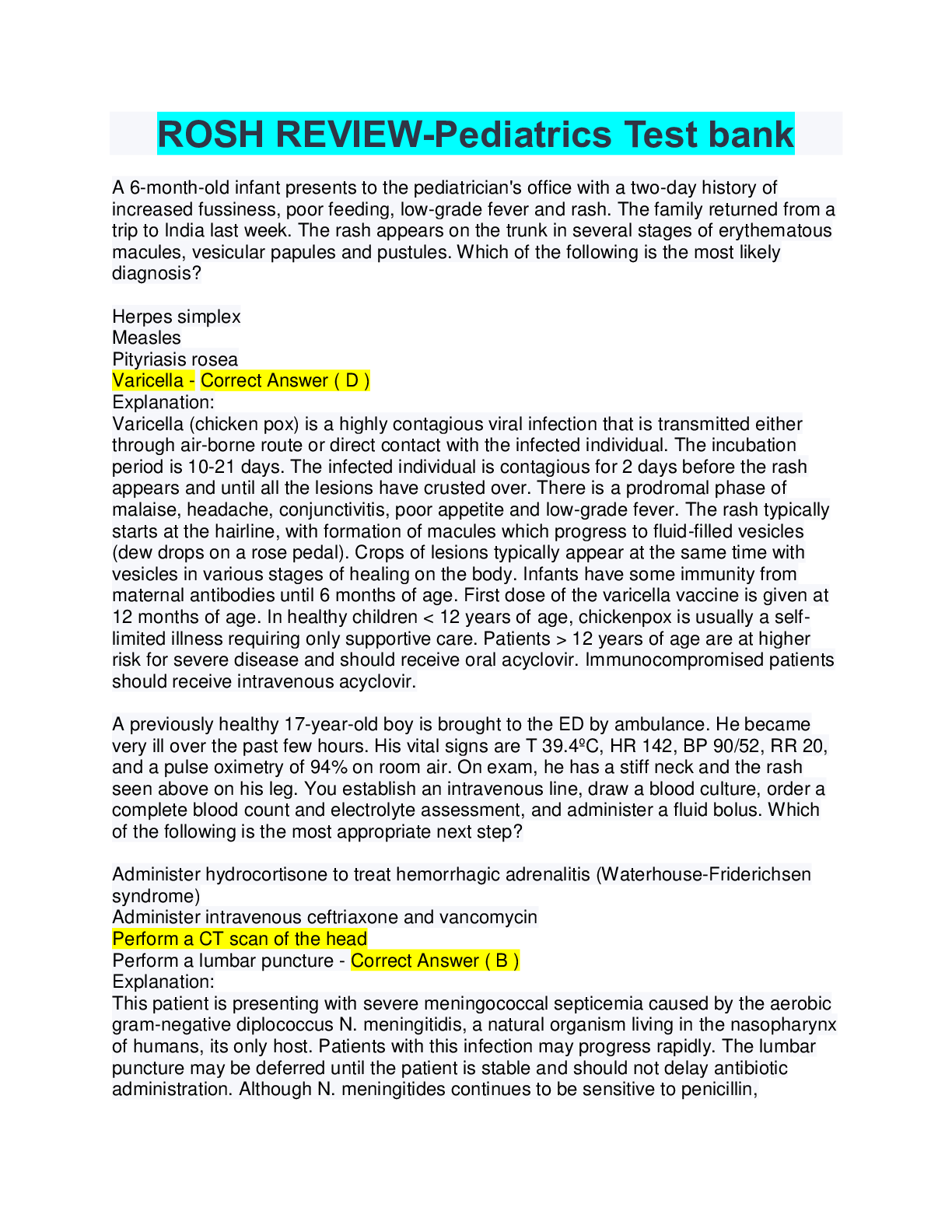
 End of Rotation Exam.png)
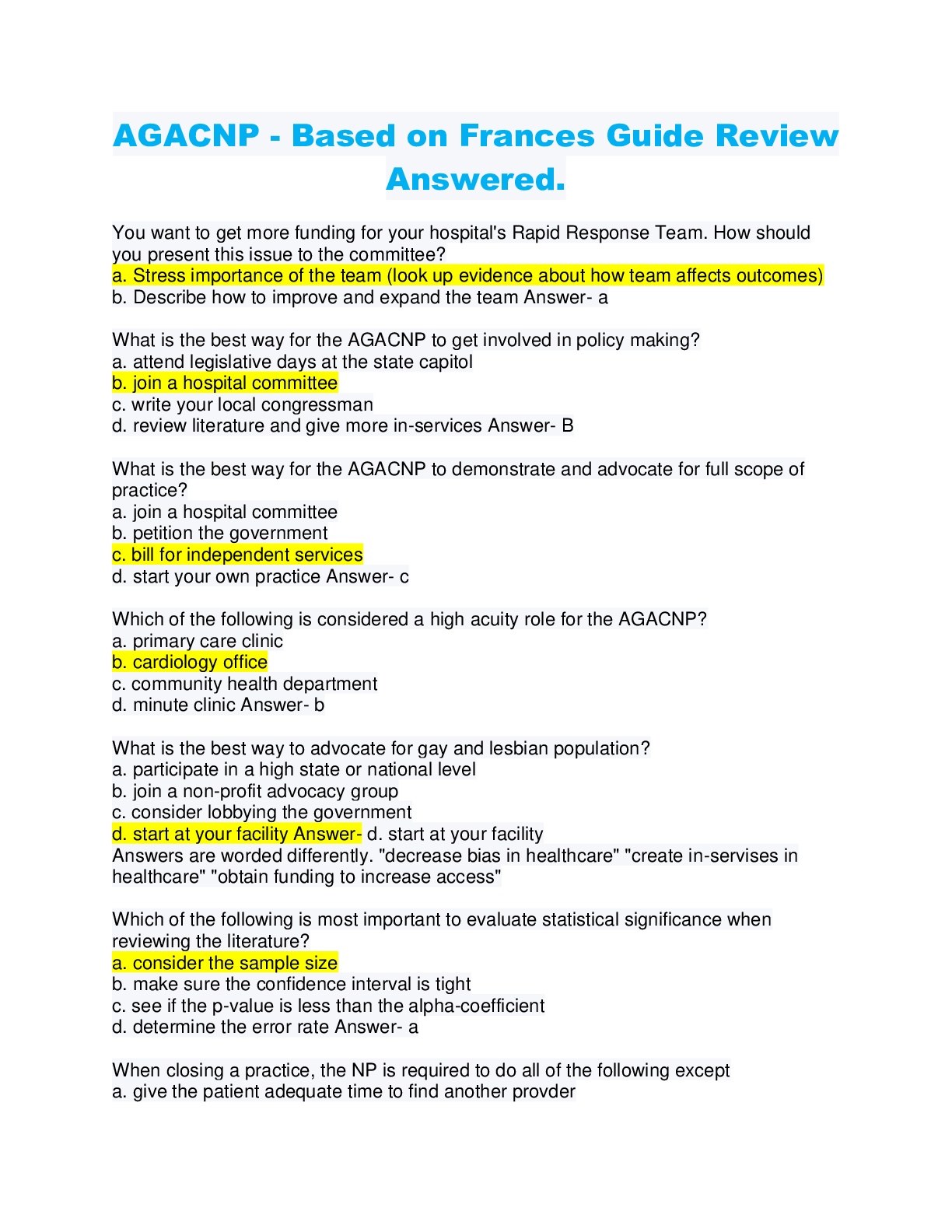
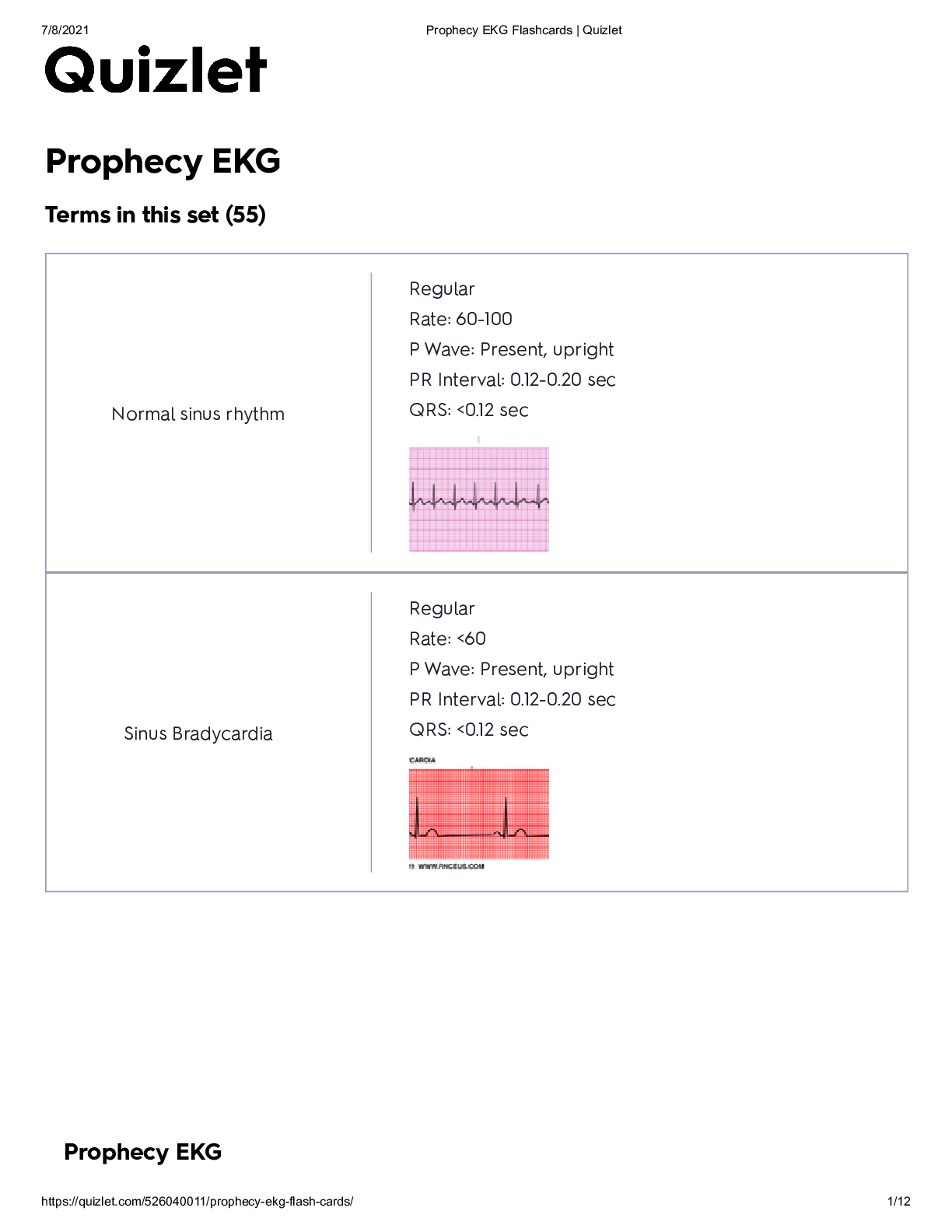
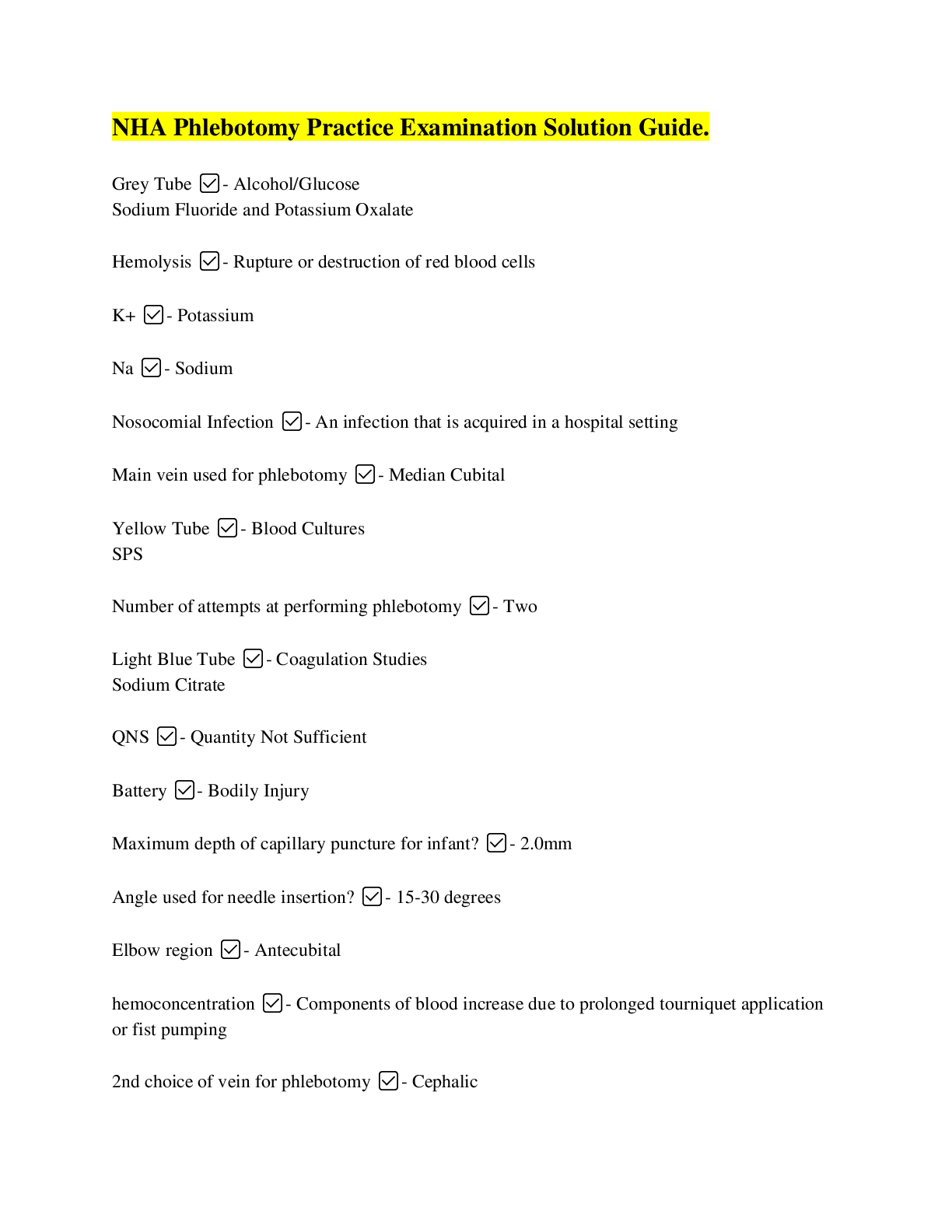
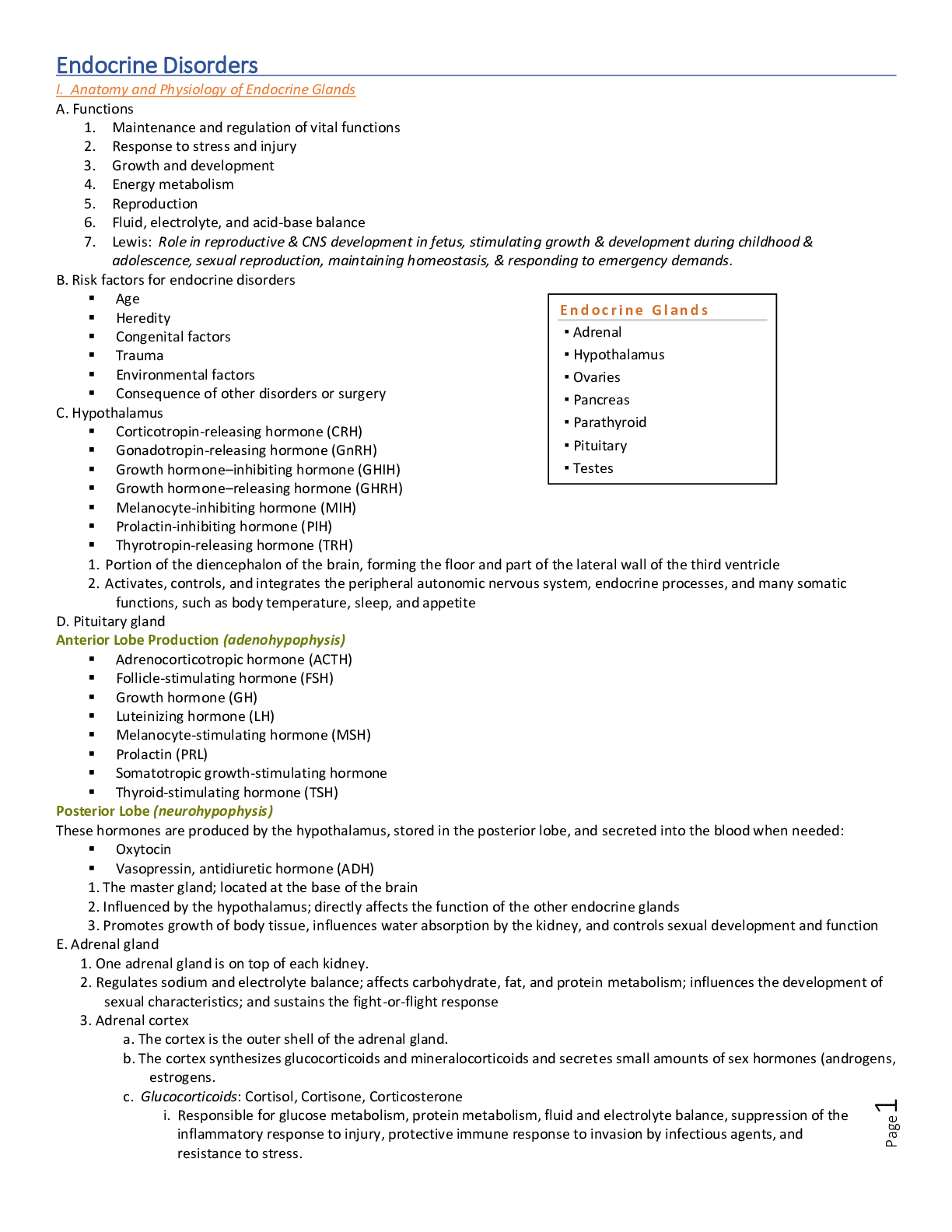
 2022 test Bank.png)
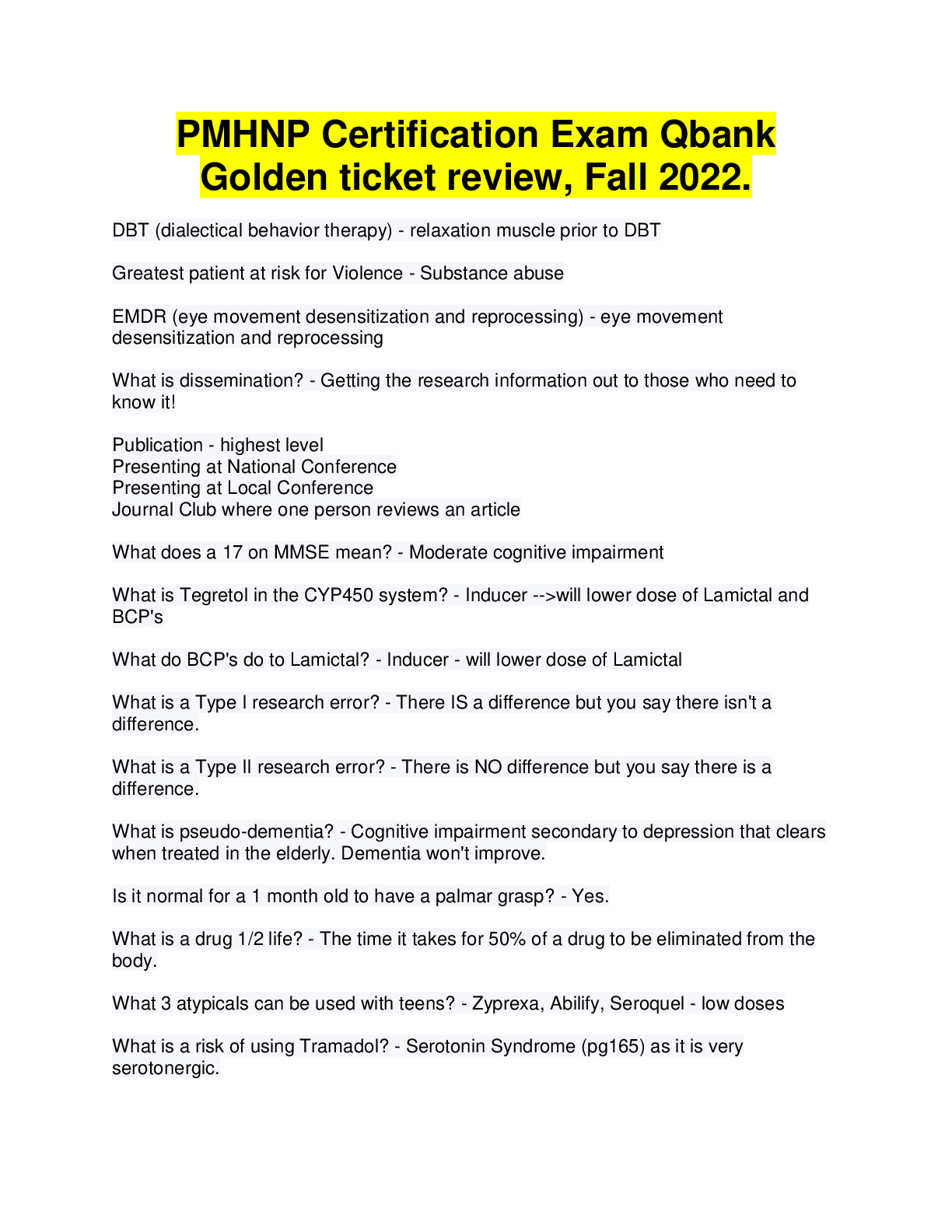
 V1-V2.png)
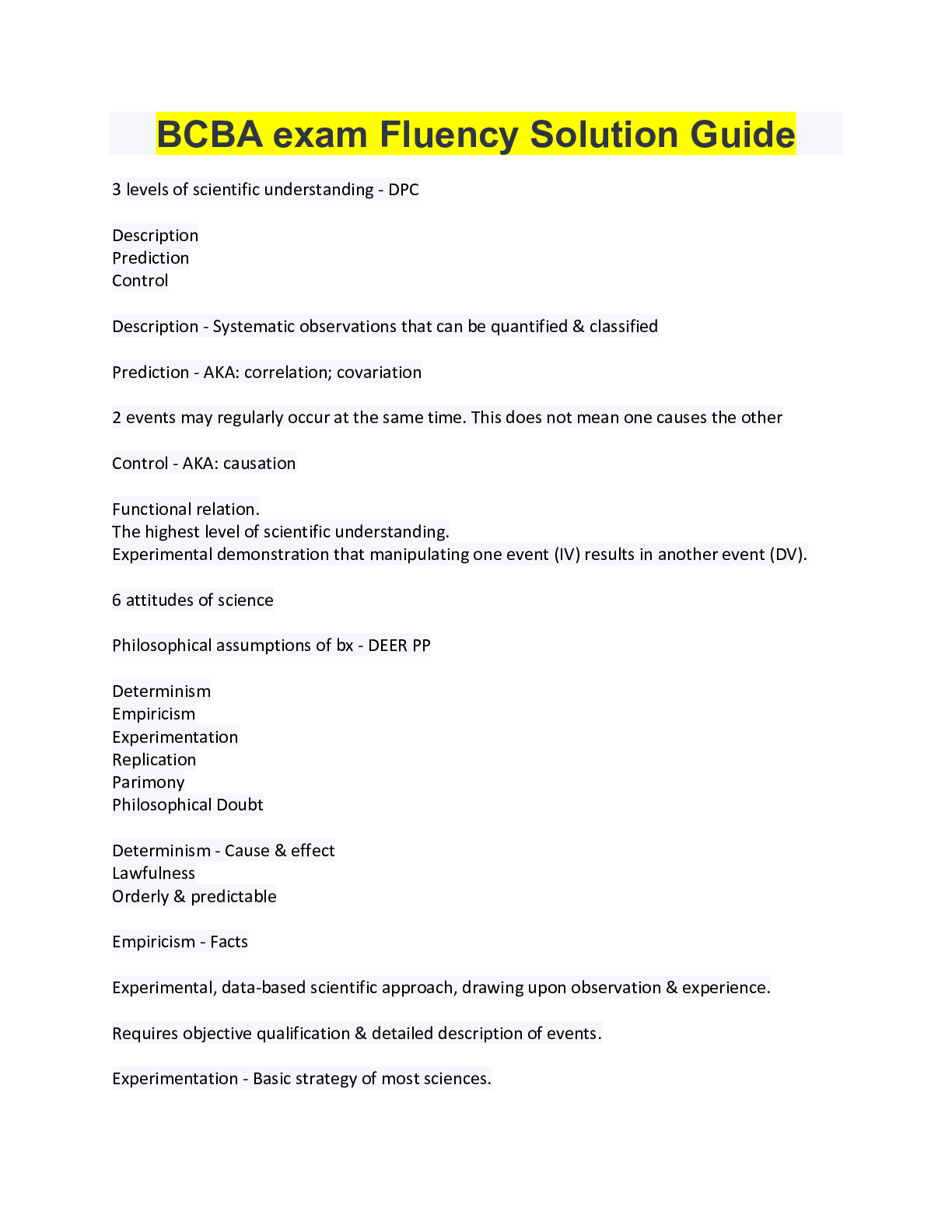
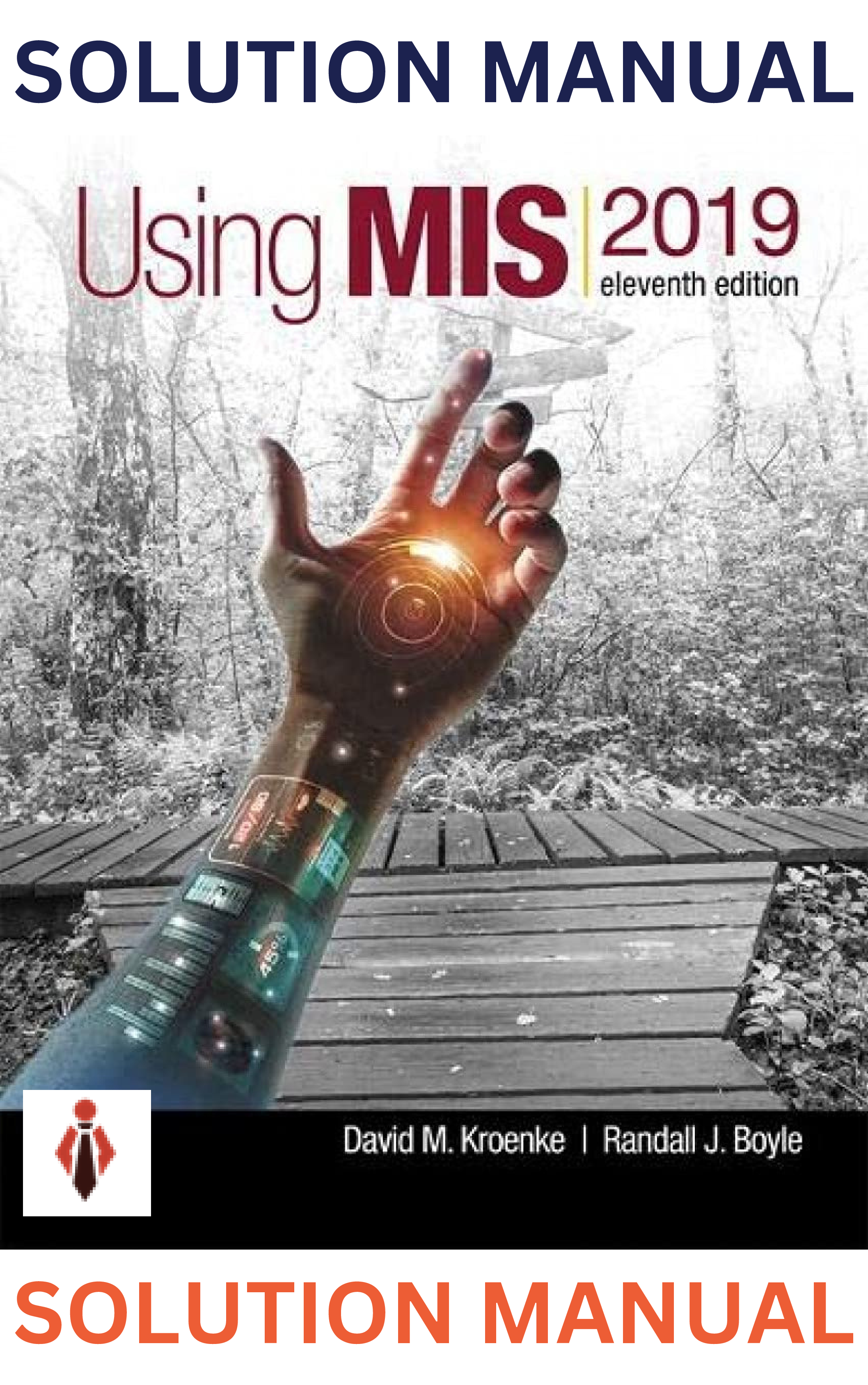

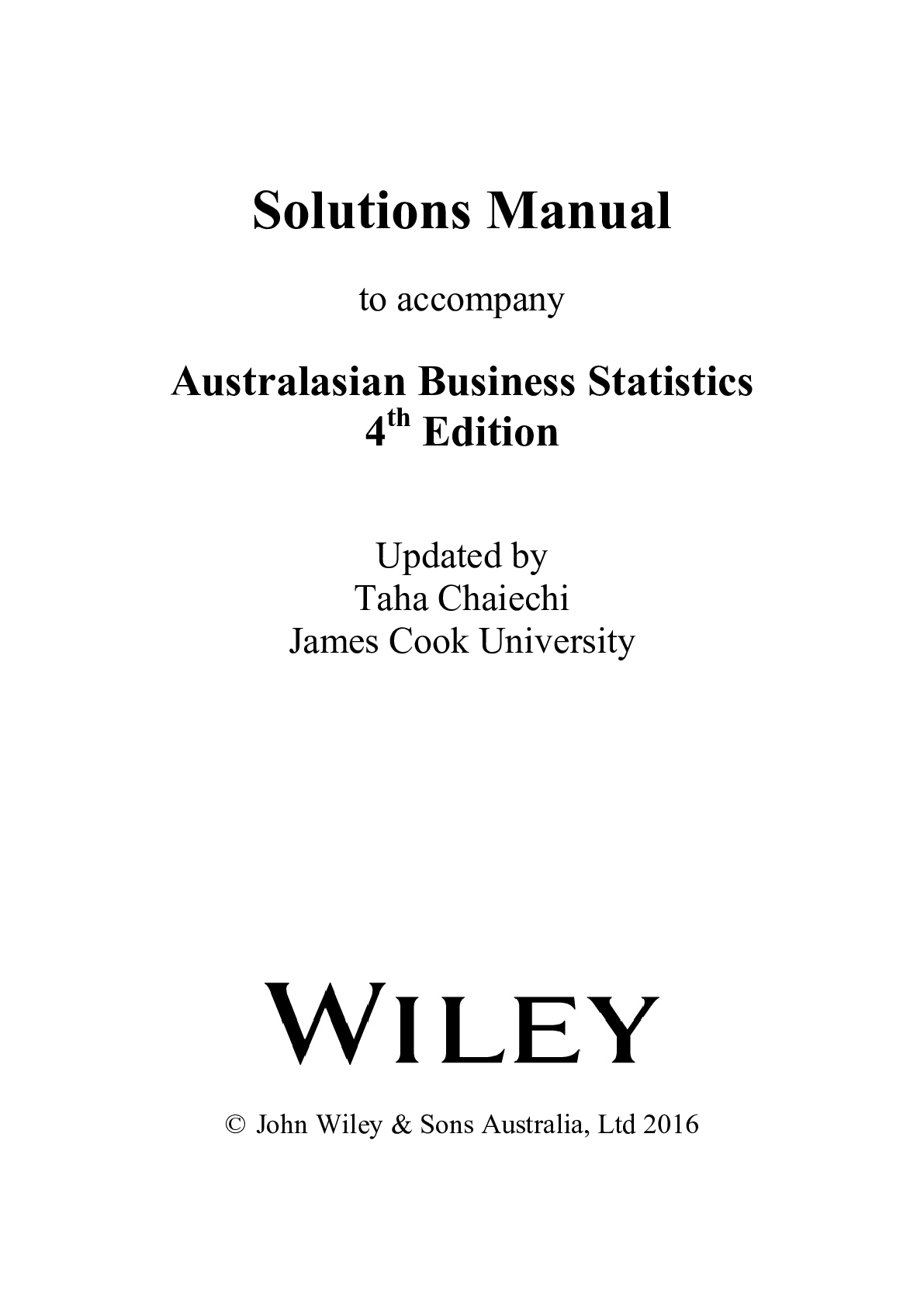

.png)
